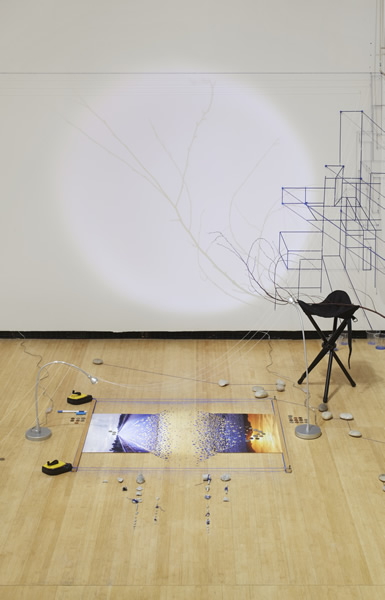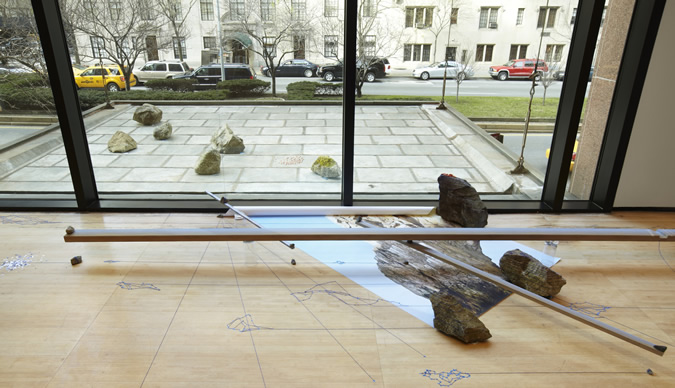Sarah Sze – Infinite Line
I admire Sarah Sze for her sculpture, but it was the promise of seeing how she might translate her art into flatwork that drew me to her show currently up at the Asia Society, Infinite Line. The show presents the two as distinct bodies of work, in two separate galleries on opposite sides of an atrium. The sculpture is as impressive as one might expect, and leaves the drawings, collages, and paintings in its shadow. Despite the clear curatorial line between these two groups of works, however, the best pieces of either group are those that sit between drawing and sculpture, bridging wall and floor, at and volumetric. This was the artist’s clear intent with the show, which she easily accomplishes in more ways than one.
Sze brings to Infinite Line three recurring interests: the combination of ordinary objects, abstraction as it appears in such objects as the tension of gravity, and the manipulation of the viewer into using their own gaze to create a picture that, though independent of the action of the artist, seems to be a part of her piece. The latter is what she does best here, and what interests me the most about her work. But, in the installation portion of the show, at least, Sze does well with each of these topics, and with the obvious challenge of merging drawing and sculpture.
Since the piece that first brought her attention, an untitled assortment of chewed-toilet-paper artifacts at the 1996 Soho Annual, Sze has been focused on the conflict of connotation in art: the conflict between what an element is and what we perceive it to be. What is remarkable and refreshing about Sze is how she approaches this in an architectural manner, while at the same time repurposing elements of architecture into sculpture, where they can be better appreciated for their exhibition value alone— the sort of appreciation that her first piece isolated and highlighted. The installations on display here continue that thread, since these beautiful works are composed of banal, artistically worthless objects put together to create structures that compel the viewer physically in space.

Random Walk Drawing (Water); 2011; Mixed Media / Courtesy of the artist and Tanya Bonakdar Gallery, New York / Photo courtesy of Tom Powel
Though the objects she uses are familiar, in using them she not only takes them out of their expected context into that of art, but she investigates their forms and functions and puts them to new uses. Looking at the individual pieces, we are impressed by her cleverness in repurposing these objects for art, and are defamiliarized from it, while not loosing sight of the whole piece of which it is a part. Simultaneously, Sze is deconstructing other forms, in this case, two-dimensional images, and by repurposing these objects, she recreates them in ways that are also clever and defamiliarizing. Rather than being simply wholes made out of surprising parts, Sze’s pieces function as well in their aspects as in their totality. This is where she ends up imbuing not only the whole, composed of worthless parts, with value, but giving each individual part its own value above that which it had before she acted on it. Thus she takes a desk lamp and a twig and, placing them together with the light on the twig, makes an installation that is both sculpture of the two in relation to one another and to the viewer and a drawing cast on the wall.
It is the investigation of two-dimensional images in this way that really makes the show. There are drawings, of course, but these aren’t anywhere near as interesting; and there are posters incorporated into the installations, and installations that hang partly on the wall like pictures, but the way that she really pushes drawing and sculpture together, by way of architecture, is by framing points of view with the installations. In her past, much larger pieces, the architectural influence was easy to see. The larger pieces guided viewers through them, in part by effecting the viewer physically in their sense of space and controlling his gaze by surrounding him as architecture does; with these smaller pieces, however, she must rely on reference to drawing, yet she still maintains her architectural means of effecting the viewer. In one piece this is accomplished by folding a wire-frame form into perspective. While the form remains three-dimensional, its collapse favors a certain angle from which it falls into one-point perspective, for the most part. In another, a series of real rocks are mimicked by drawings (on the ground – with string and tape) of similar rocks. In a few cases, the sculpture shines a small light on itself in such a way as to make a specific part of it an image. Most impressive, however, is the piece in which she continues an arrangement of rocks out of a window and onto an awning over Park Avenue. The result is a sculpture that consists of an image of the world outside the gallery – not only breaking the separation of the gallery space, and of art and its situation, but making the result into a picture by making the window a frame, which we cannot penetrate, within which lies a picture the artist has made. The piece fits in with the rest of the show by its anchoring in the gallery, outside and in front of the frame of the window and relates it to us as sculpture, like the other, unframed pieces. If she can blur the line between sculpture and flatwork like this, why bother with actual flatwork? At least, that’s the opinion that I arrived at, returning only to the installation gallery on subsequent visits.
This game that Sze plays with drawing and sculpture, wall and floor, takes place in addition, and by way of, her usual acrobatics of object and scale in relation to the viewer. But, by virtue of her focus in these pieces, the result is quite different from pieces shown in such recent exhibitions as at Tanya Bonakdar in 2010. Though by no means small, the work on display here is scaled down in every way; this pushes the focus away from literally overwhelming and surrounding the viewer, and puts more emphasis on getting the viewer, by way of his or her attention to the minute, playful details to let themselves be overwhelmed in their investigation. In Infinite Line Sze subtly explores new territory, and the results are fantastic, as her installation work continues to meet every new challenge that she sets for it.

Random Walk Drawing (Window); 2011; Mixed Media , Courtesy of the artist and Tanya Bonakdar Gallery, New York / Photo courtesy of Tom Powel
This game that Sze plays with drawing and sculpture, wall and floor, takes place in addition, and by way of, her usual acrobatics of object and scale in relation to the viewer. But, by virtue of her focus in these pieces, the result is quite different from pieces shown in such recent exhibitions as at Tanya Bonakdar in 2010. Though by no means small, the work on display here is scaled down in every way; this pushes the focus away from literally overwhelming and surrounding the viewer, and puts more emphasis on getting the viewer, by way of his or her attention to the minute, playful details to let themselves be overwhelmed in their investigation. In Infinite Line Sze subtly explores new territory, and the results are fantastic, as her installation work continues to meet every new challenge that she sets for it.





